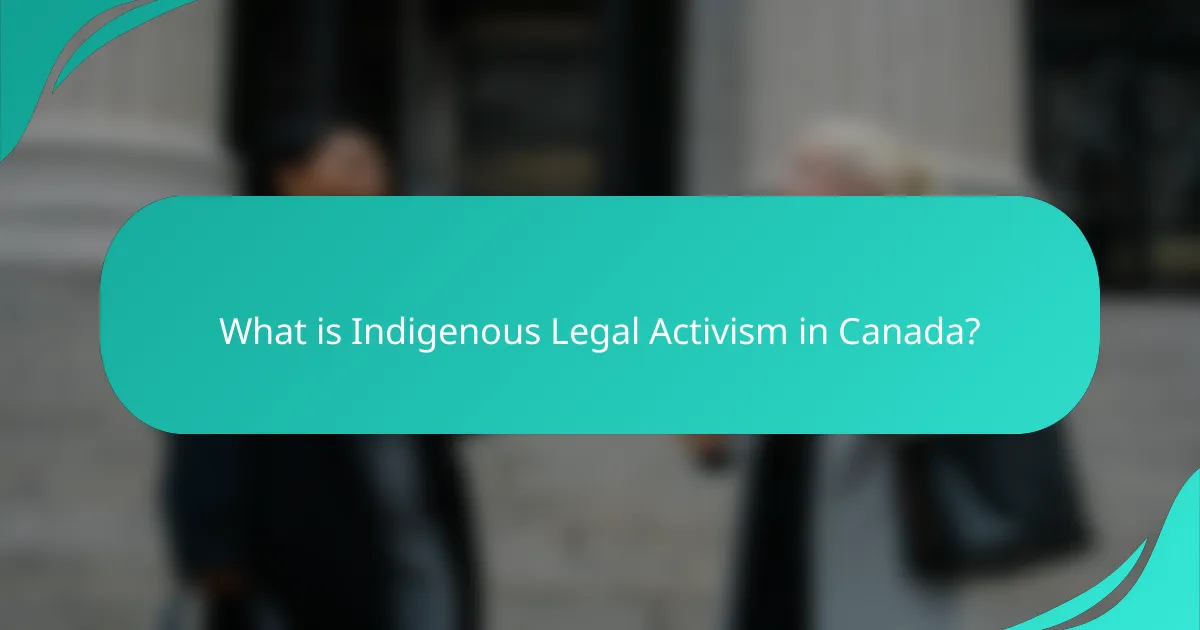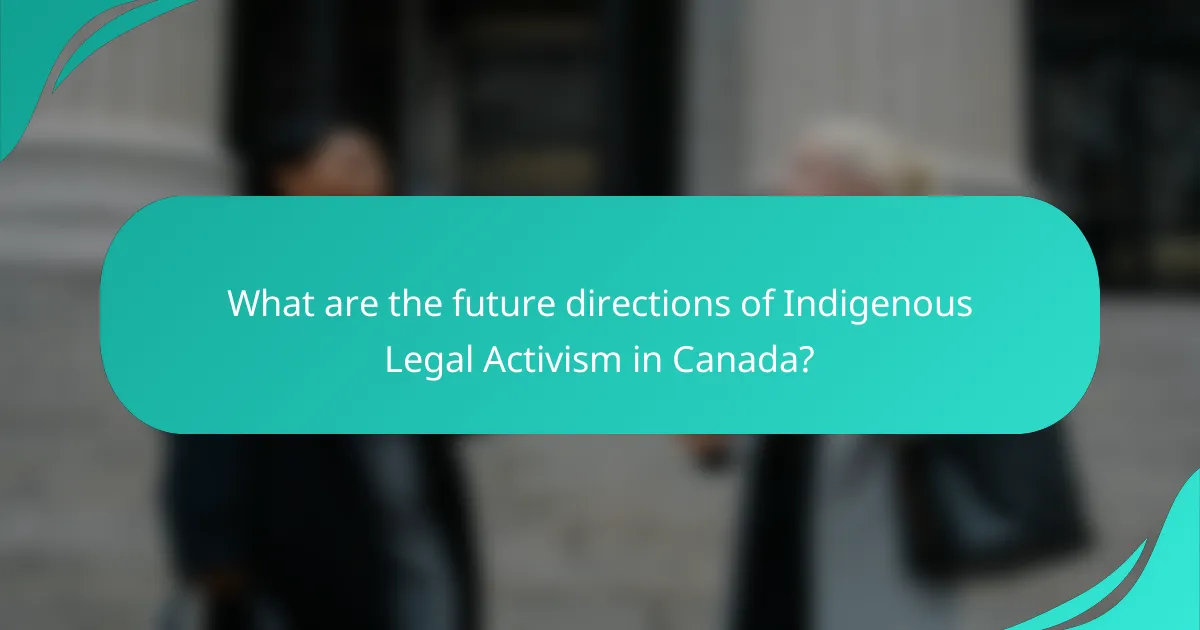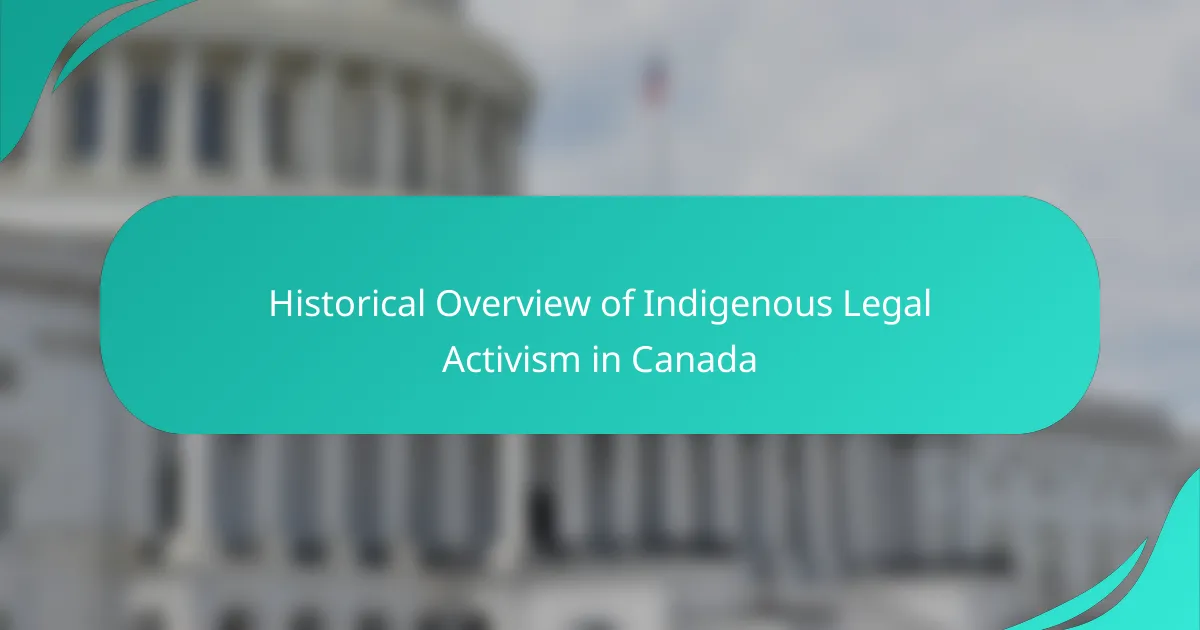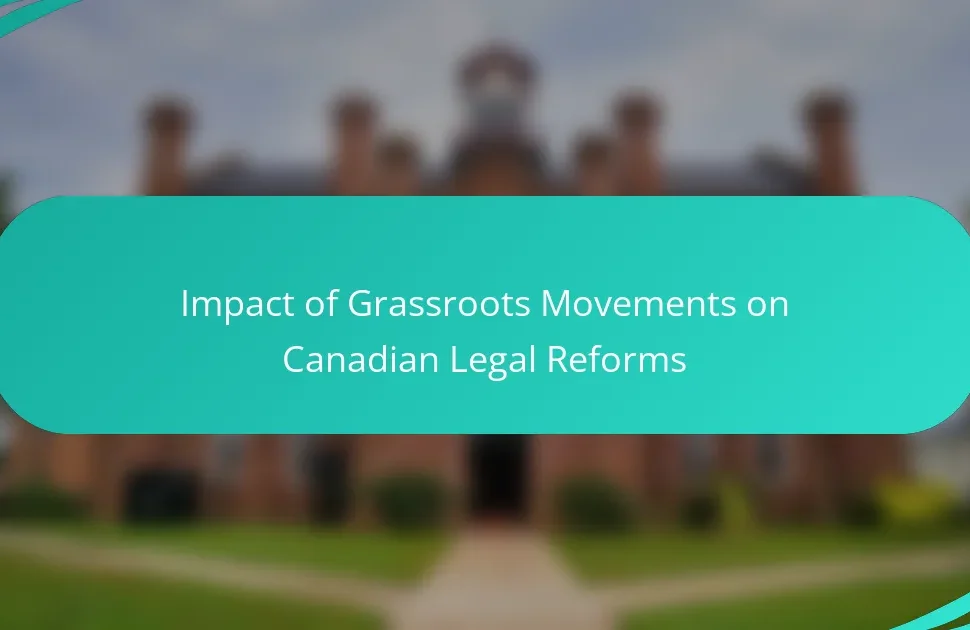
What is Indigenous Legal Activism in Canada?
Indigenous Legal Activism in Canada refers to the efforts by Indigenous peoples to assert their legal rights and sovereignty through the legal system. This activism aims to challenge injustices and advocate for the recognition of treaties and land rights. It has roots in historical grievances stemming from colonial policies and systemic discrimination. Indigenous activists utilize litigation, public campaigns, and legal education to promote their causes. The landmark case of Calder v. British Columbia (1973) recognized Indigenous land rights and set a precedent for future claims. Additionally, the creation of the Truth and Reconciliation Commission has highlighted the need for legal reforms. Overall, Indigenous Legal Activism plays a crucial role in advancing social justice and legal recognition for Indigenous communities in Canada.
How has Indigenous Legal Activism evolved over time?
Indigenous legal activism has evolved significantly over time in Canada. Initially, Indigenous groups focused on land rights and treaty recognition. The 1969 White Paper proposed the elimination of the Indian Act, prompting strong resistance from Indigenous leaders. In the 1970s, the formation of organizations like the Assembly of First Nations strengthened collective action. Landmark legal cases, such as Calder in 1973, recognized Indigenous land rights in court. The Constitution Act of 1982 included Section 35, affirming Indigenous rights. More recently, activism has expanded to include environmental justice and self-determination. The rise of social media has also transformed advocacy methods, allowing for broader outreach and mobilization.
What key historical events have shaped Indigenous Legal Activism?
Key historical events that have shaped Indigenous legal activism include the Royal Proclamation of 1763. This proclamation recognized Indigenous land rights and established a framework for treaties. The Indian Act of 1876 further marginalized Indigenous peoples and spurred resistance. The Calder case in 1973 was significant as it acknowledged Indigenous land rights in British Columbia. The Constitution Act of 1982 included Section 35, which recognized existing Indigenous rights. The Oka Crisis of 1990 highlighted land disputes and increased awareness of Indigenous issues. The Truth and Reconciliation Commission, established in 2008, addressed the legacy of residential schools and called for legal reforms. Each of these events has contributed to the evolution of Indigenous legal activism in Canada.
What role have Indigenous leaders played in this activism?
Indigenous leaders have been pivotal in Indigenous legal activism in Canada. They have advocated for land rights, treaty rights, and self-determination. Leaders such as Chief Dan George and Elijah Harper mobilized communities and raised awareness. They played key roles in landmark legal cases, like the Calder case in 1973. This case recognized Indigenous land rights, setting a precedent for future claims. Indigenous leaders have also participated in negotiations with the Canadian government. Their efforts have led to the establishment of the Royal Commission on Aboriginal Peoples in 1996. This commission provided recommendations for policy changes to improve Indigenous rights. Overall, Indigenous leaders have been essential in shaping legal frameworks and advocating for justice.
Why is Indigenous Legal Activism important in Canada?
Indigenous legal activism is important in Canada because it seeks to address historical injustices and uphold Indigenous rights. This activism plays a crucial role in advocating for the recognition of treaties and land claims. It also aims to protect Indigenous cultures and traditions through legal means. Moreover, Indigenous legal activism influences policy changes that benefit Indigenous communities. The Supreme Court of Canada has recognized Indigenous rights in landmark cases, such as the Calder case in 1973. This recognition has led to significant legal precedents that support Indigenous sovereignty. Additionally, Indigenous legal activism fosters greater awareness and understanding of Indigenous issues among the broader Canadian population. It empowers Indigenous peoples to assert their rights and seek justice in a legal framework.
What are the social implications of Indigenous Legal Activism?
Indigenous legal activism has significant social implications, including the promotion of Indigenous rights and recognition of sovereignty. It challenges systemic injustices faced by Indigenous communities. This activism influences public policy and legal frameworks in Canada. For example, landmark cases like Calder v. British Columbia (1973) recognized Indigenous land rights. Such legal victories foster greater awareness and understanding of Indigenous issues among the general public. They also encourage dialogue between Indigenous and non-Indigenous populations. Furthermore, Indigenous legal activism strengthens community identity and resilience. It empowers Indigenous youth to engage in activism and legal studies. Overall, these implications contribute to social change and reconciliation efforts in Canada.
How does Indigenous Legal Activism influence Canadian law and policy?
Indigenous legal activism significantly influences Canadian law and policy. It challenges existing legal frameworks and promotes the recognition of Indigenous rights. This activism has led to landmark court decisions, such as the Calder case in 1973, which acknowledged Indigenous land rights. Additionally, the 1997 Delgamuukw decision affirmed the importance of oral histories in land claims. These legal victories have prompted legislative changes, including the implementation of the United Nations Declaration on the Rights of Indigenous Peoples in Canadian law. Indigenous activists also advocate for policy reforms, influencing areas like environmental protection and resource management. Overall, Indigenous legal activism reshapes the legal landscape, fostering greater recognition and respect for Indigenous sovereignty and rights.

What are the major movements within Indigenous Legal Activism?
Major movements within Indigenous Legal Activism include the land rights movement, the self-determination movement, and the environmental justice movement. The land rights movement focuses on reclaiming traditional territories and asserting Indigenous ownership. This movement gained momentum in the 1960s and 1970s, leading to landmark cases like Calder v. British Columbia in 1973. The self-determination movement advocates for Indigenous governance and autonomy. It emphasizes the right of Indigenous peoples to make decisions affecting their communities. The environmental justice movement addresses the disproportionate impact of environmental degradation on Indigenous lands and communities. This movement has led to legal challenges against resource extraction projects that threaten Indigenous territories. Each of these movements has played a crucial role in shaping Indigenous legal rights in Canada.
How do land rights movements contribute to Indigenous Legal Activism?
Land rights movements significantly contribute to Indigenous legal activism by advocating for the recognition and protection of Indigenous land entitlements. These movements mobilize communities to assert their rights against governmental and corporate encroachments. They raise awareness about historical injustices and legal frameworks that have marginalized Indigenous peoples.
Land rights movements often lead to landmark legal cases that challenge discriminatory laws and practices. For instance, the Calder case in 1973 recognized Indigenous land rights in Canada, setting a precedent for future activism. This legal recognition empowers Indigenous groups to negotiate treaties and seek restitution.
Moreover, these movements foster solidarity among Indigenous communities, enhancing collective action. They also engage non-Indigenous allies, broadening support for Indigenous rights. Overall, land rights movements serve as a catalyst for legal reforms that affirm Indigenous sovereignty and self-determination.
What are the landmark cases related to land rights in Canada?
The landmark cases related to land rights in Canada include Calder v. British Columbia, Delgamuukw v. British Columbia, and Tsilhqot’in Nation v. British Columbia. Calder v. British Columbia, decided in 1973, recognized Aboriginal title in Canada for the first time. Delgamuukw v. British Columbia, decided in 1997, confirmed the existence of Aboriginal land title and the importance of oral histories in proving land claims. Tsilhqot’in Nation v. British Columbia, decided in 2014, was the first case to grant a declaration of Aboriginal title to a specific area of land. These cases have significantly shaped the legal landscape regarding Indigenous land rights in Canada.
How have these movements affected Indigenous communities?
Indigenous legal activism movements have significantly impacted Indigenous communities in Canada. These movements have led to increased recognition of Indigenous rights. Landmark cases, such as Calder v. British Columbia, affirmed land rights and self-governance. Activism has also prompted legislative changes, including the adoption of the United Nations Declaration on the Rights of Indigenous Peoples. Increased visibility of Indigenous issues has fostered greater public awareness and support. Moreover, these movements have empowered Indigenous youth and leaders to advocate for their communities. The result is a stronger collective identity and resilience among Indigenous peoples. Overall, the activism has catalyzed positive changes in policy and societal attitudes toward Indigenous rights in Canada.
What role does legal representation play in Indigenous Legal Activism?
Legal representation is crucial in Indigenous legal activism as it provides advocacy and support in legal matters. Indigenous communities often face systemic legal challenges. Legal representatives help navigate these complexities. They assist in litigation, negotiation, and policy advocacy. This representation is vital for asserting Indigenous rights and sovereignty. Historical cases, such as the Calder case in 1973, highlight the impact of legal representation. In this case, legal counsel played a key role in recognizing Indigenous land rights. Effective legal representation empowers Indigenous voices in legal systems. It also fosters greater awareness of Indigenous issues within broader society.
How do Indigenous lawyers contribute to legal activism?
Indigenous lawyers contribute to legal activism by advocating for the rights of Indigenous peoples. They utilize their legal expertise to challenge injustices in the legal system. This includes addressing issues such as land rights, treaty rights, and cultural preservation. Indigenous lawyers often represent clients in court cases that set important legal precedents. They also engage in policy advocacy to influence legislation affecting Indigenous communities. Their work helps raise public awareness about Indigenous issues. Additionally, they mentor and support emerging Indigenous legal professionals. This fosters a new generation of advocates committed to social justice.
What challenges do Indigenous legal representatives face?
Indigenous legal representatives face significant challenges in their work. They often encounter systemic barriers within the legal system. These barriers include a lack of understanding of Indigenous laws and cultures by non-Indigenous legal professionals. Additionally, funding limitations restrict the resources available for legal representation. Geographic isolation can hinder access to legal services for Indigenous communities. Furthermore, there is often a mistrust of the legal system among Indigenous peoples due to historical injustices. These factors contribute to the difficulties Indigenous legal representatives experience in advocating for their clients effectively.

What are the future directions of Indigenous Legal Activism in Canada?
The future directions of Indigenous legal activism in Canada focus on enhancing self-determination and treaty rights. Indigenous communities are increasingly advocating for legal recognition of their sovereignty. This includes pursuing claims for land restitution and resource management. The incorporation of Indigenous legal traditions into Canadian law is also a key goal. Activists emphasize the importance of collaborative governance models. Strengthening relationships with non-Indigenous allies is essential for broader support. Legal education and capacity-building within Indigenous communities are critical for sustainable activism. Recent court rulings, such as the Supreme Court’s recognition of Indigenous rights, reinforce these directions.
How can new technologies support Indigenous Legal Activism?
New technologies can support Indigenous legal activism by enhancing communication and mobilization. Digital platforms allow for the rapid dissemination of information regarding legal rights and issues. Social media enables Indigenous communities to share their stories and organize campaigns effectively. Online petitions can gather support for legal causes, amplifying their reach. Access to legal resources through websites and apps empowers individuals to understand their rights. Technologies such as video conferencing facilitate remote collaboration among activists and legal experts. Data collection tools help document legal injustices, providing evidence for advocacy. Overall, these technologies create a more connected and informed network for Indigenous legal activism.
What are the potential benefits of digital advocacy for Indigenous rights?
Digital advocacy for Indigenous rights can enhance visibility and awareness of issues. It allows Indigenous communities to share their narratives directly with a global audience. This direct communication can foster solidarity and support from allies. Digital platforms enable rapid mobilization for campaigns and events. They also facilitate the organization of resources and information sharing among communities. Increased access to information can empower Indigenous individuals to engage in activism. Online advocacy can attract media attention, amplifying the message. This heightened visibility can influence policy discussions and decisions.
How can social media amplify Indigenous voices in legal matters?
Social media can amplify Indigenous voices in legal matters by providing a platform for direct communication and advocacy. It allows Indigenous communities to share their narratives and experiences widely. This increased visibility can attract public attention to legal issues affecting Indigenous peoples. Social media also facilitates the organization of campaigns and mobilization of support. For instance, hashtags can unify voices around specific legal cases or injustices. Additionally, social media can connect Indigenous activists with legal experts and allies. This collaboration can enhance the effectiveness of legal strategies. Research shows that social media engagement has led to successful legal outcomes in various Indigenous rights cases.
What strategies can enhance the effectiveness of Indigenous Legal Activism?
Building coalitions with allied organizations can enhance Indigenous Legal Activism. Collaborating with environmental groups and human rights organizations strengthens advocacy efforts. Utilizing social media platforms increases visibility and mobilizes support. Engaging in public education campaigns raises awareness of Indigenous rights and issues. Leveraging legal precedents from successful cases can guide future activism. Training Indigenous activists in legal strategies empowers communities to advocate effectively. Securing funding from grants and donations supports sustained activism efforts. Documenting and sharing success stories inspires further engagement and activism.
How can partnerships with non-Indigenous organizations improve outcomes?
Partnerships with non-Indigenous organizations can enhance outcomes for Indigenous communities through resource sharing and collaborative advocacy. These partnerships often provide access to funding, expertise, and networks that may not be available within Indigenous organizations alone. For instance, non-Indigenous organizations can offer legal support and policy advocacy that align with Indigenous rights and issues. This collaboration can lead to more effective strategies for addressing systemic injustices. Evidence shows that joint initiatives have resulted in successful legal cases that protect Indigenous land rights. Additionally, partnerships can foster mutual understanding and respect, promoting cultural exchange and awareness. Overall, these collaborations can create a stronger collective voice for Indigenous issues in legal and political arenas.
What best practices should be adopted for successful activism?
Successful activism requires clear goals and effective communication. Defining specific objectives helps focus efforts. Engaging with the community builds support and awareness. Collaborating with other organizations amplifies impact. Utilizing social media enhances outreach and mobilization. Educating the public fosters understanding and empathy. Documenting progress is essential for accountability and momentum. Historical examples, such as Indigenous legal activism in Canada, demonstrate the effectiveness of these practices.
Indigenous Legal Activism in Canada is the collective effort by Indigenous peoples to assert their legal rights and sovereignty through the legal system, addressing historical injustices related to land and treaty rights. This article provides a historical overview of the evolution of Indigenous legal activism, highlighting key events, landmark cases, and the role of Indigenous leaders in advocating for social justice. It discusses major movements such as land rights, self-determination, and environmental justice, while also examining the influence of legal representation and the impact of technology on activism. The article emphasizes the importance of these efforts in shaping Canadian law and policy, fostering greater awareness of Indigenous issues, and promoting reconciliation.




